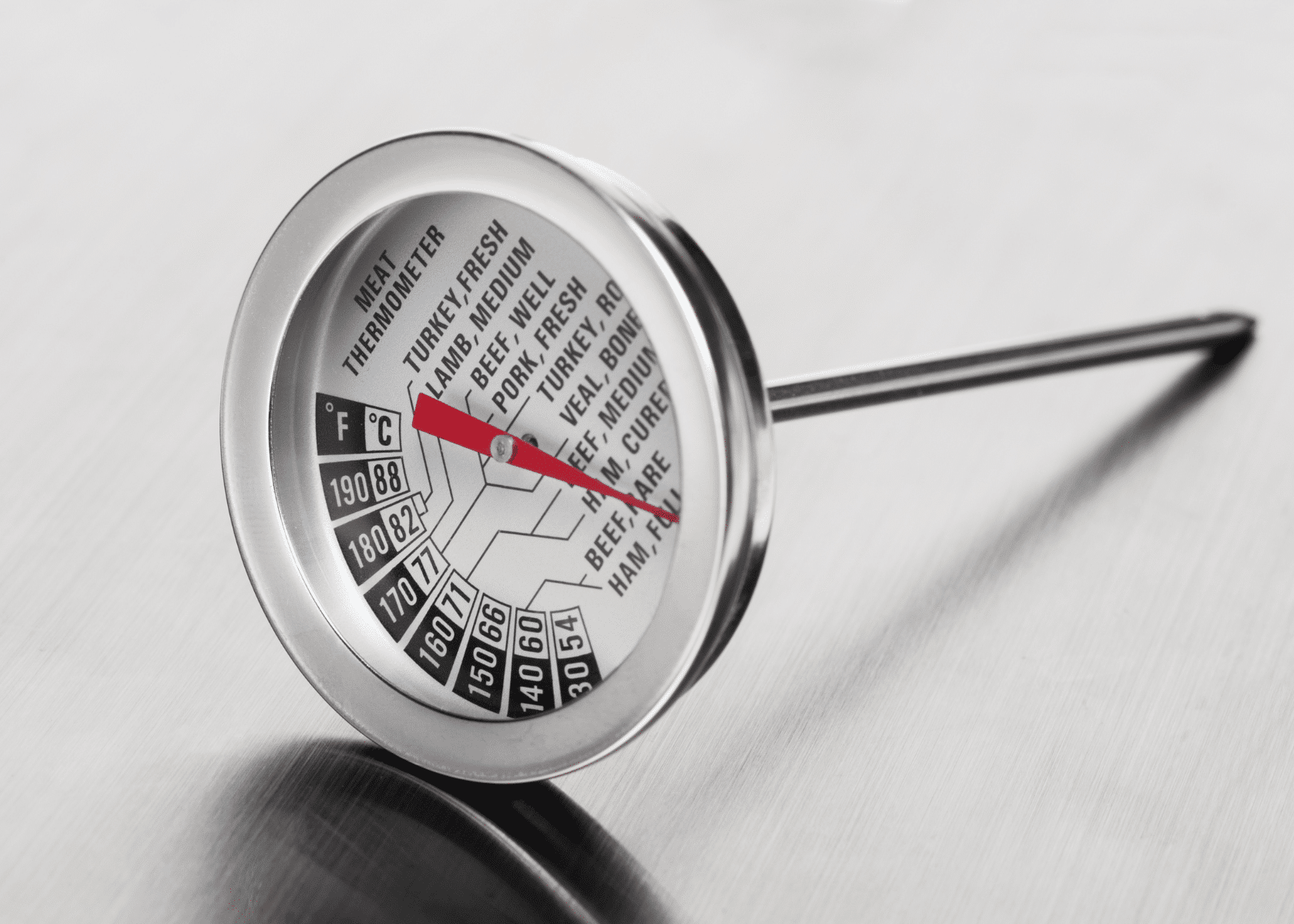In times of a health crisis or thermometer shortage, you may find yourself asking: “Can I use a meat thermometer to take my body temperature?” While it’s not common practice, some instant-read digital meat thermometers can indeed measure human body heat.
However, there are several considerations and limitations to this method that we’ll explore in detail throughout this article. Ready? Let’s dive into the world of improvised temperature-taking!
Key Takeaways
- Using a meat thermometer to take your body temperature is not a good choice due to several factors.These include temperature range differences, design and calibration issues, accuracy concerns with infrared guns, lack of FDA approval and medical-grade standards, and sanitary considerations.
- Meat thermometers are best for measuring the internal temperature of cooked meats, which has a wider range compared to human body temperature. This can lead to inaccurate results when using them as makeshift thermometers.
- It’s important to choose a thermometer specifically designed and calibrated for measuring body temperature, such as digital or glass thermometers. These options provide more accurate readings and adhere to medical-grade standards.
- Infrared thermometers may offer quick readings without direct contact. However, their accuracy may depend on factors like distance from the measured object and environmental conditions. It’s best to rely on approved medical-grade instruments for precise results in health-related situations.
Understanding Meat Thermometers and Body Thermometers
Meat thermometers measure the internal temperature of meats during cooking, while body thermometers take accurate readings of human body temperature.
How meat thermometers work
Meat thermometers, prevalent in kitchens worldwide, provide an efficient method of determining the cooking status of meats. The functionality derives from a sensitive probe that can detect heat fluctuations accurately.
When inserted into meat, this tool measures the internal temperature to ensure it reaches the safe levels set by food health regulations. While most are stand-alone manual devices, digital instant-read meat thermometers have recently gained popularity as they offer fast and precise readings on a clear display within seconds.
This speediness stems from digital sensors located at the probe tip which achieve significantly faster read times than traditional models—which rely on metal springs to expand with heat—hence making them suitable for chefs desiring more control over their cooking process.
Different types of body thermometers
There are several types of body thermometers available that are perfect for measuring body temperature accurately. These include:
- Digital Thermometers: Digital thermometers are the most common type for taking body temperature. They use an electronic sensor to measure temperature and display the reading on a digital screen. You may use them orally, rectally, or under the armpit.
- Glass Mercury Thermometers: Although less common these days due to safety concerns, glass mercury thermometers are still used in some medical settings. They contain a small amount of mercury that expands when exposed to heat, indicating the temperature on a graduated scale.
- Infrared (IR) Thermometers: Infrared thermometers provide non-contact temperature measurement by detecting infrared energy emitted from the body. They can measure temperature by pointing them at the forehead or temple without physical contact.
- Ear (Tympanic) Thermometers: Ear thermometers use infrared sensors to measure the temperature inside the ear canal. They are quick and easy to use, but proper positioning is essential for accurate readings.
- Temporal Artery (Forehead) Thermometers: These thermometers use infrared technology to measure temperature by scanning the temporal artery on the forehead. They are convenient and hygienic, providing fast and reliable results.
Why Meat Thermometers are Not Recommended for Taking Body Temperature
Meat thermometers are not the right choice for taking body temperature due to temperature range differences, design and calibration issues, accuracy concerns with infrared guns, lack of FDA approval and medical-grade standards, and sanitary considerations.
Temperature range differences
The temperature range differences between meat thermometers and body thermometers are significant. Meat thermometers measure the internal temperature of cooked meats, typically ranging from 32°F (0°C) to 212°F (100°C).
On the other hand, body thermometers are specifically calibrated to measure human body temperature, which falls within a narrower range of around 97°F (36°C) to 99°F (37.2°C). Using a meat thermometer for body temperature readings may not provide accurate results due to these differences in temperature ranges.
It is important to use a thermometer that is specifically designed for measuring body temperature to ensure accuracy and reliable readings.
Design and calibration issues

One of the main reasons why meat thermometers are not recommended for taking body temperature is due to design and calibration issues. Meat thermometers are specifically designed to measure the internal temperature of meat, which means they may not be suitable for accurately measuring body temperature.
These thermometers have different probe shapes and sizes than body thermometers, which can lead to inaccurate readings. Additionally, meat thermometers may not be properly calibrated for measuring human body temperature, leading to further inaccuracies in readings.
It’s important to use a thermometer that has been specifically designed and calibrated for measuring body temperature in order to ensure accurate results.
Despite their convenience in the kitchen, using a meat thermometer as a makeshift thermometer raises concerns about accuracy when it comes to human health. The typical accuracy of a meat thermometer for cooking purposes is around +/- 1 oF (0.5 oC), which may not be precise enough for monitoring body temperatures during illness or fever episodes.
Body thermometers, on the other hand, go through stricter regulations and calibrations required by medical standards ensuring more accurate measurements with smaller variances (+/- 0.2 – 0.3 oF).
Accuracy of infrared guns
Infrared guns, also known as infrared thermometers, are often used in non-contact temperature measurements. While they can provide quick and convenient readings without direct contact, their accuracy may not be comparable to medical-grade thermometers.
In fact, the accuracy of infrared guns can vary significantly depending on factors such as distance from the object being measured and environmental conditions.
When it comes to measuring body temperature for health purposes, it is essential to rely on more accurate and reliable methods like digital or glass thermometers. These options have been specifically designed for measuring human body temperature and are calibrated accordingly.
Lack of FDA approval and medical-grade standards
Meat thermometers are not for taking body temperature due to the lack of FDA approval and medical-grade standards. Unlike body thermometers, meat thermometers measure temperature fluctuations in meat during cooking.
They have not undergone the necessary testing and certification required for medical use.
The FDA (Food and Drug Administration) is responsible for ensuring the safety, effectiveness, and accuracy of medical devices, including body thermometers. These devices go through rigorous validation processes to meet specific standards set by regulatory authorities.
Meat thermometers do not adhere to these standards because they are intended solely for culinary purposes.
Using a meat thermometer to measure your body temperature may result in inaccurate readings or unreliable measurements. When it comes to health-related concerns like detecting fever or monitoring overall well-being, it’s crucial to rely on approved medical-grade instruments that provide accurate results consistently.
Sanitary concerns
Sanitary concerns are a significant issue when considering the use of a meat thermometer for taking body temperature. Meat thermometers are best to use with raw meat, which means they may come into contact with bacteria and other potentially harmful substances.
Using a meat thermometer to measure your body temperature without proper cleaning and sanitization can lead to cross-contamination and the spread of germs. It is critical to maintain strict hygiene practices when using any device intended for food-related purposes, especially if you plan on repurposing it for measuring body temperature.
Properly disinfecting the probe of the meat thermometer with alcohol or another suitable sanitizer before each use is crucial in order to minimize any health risks associated with bacterial contamination.
Proper Methods for Taking Body Temperature
– Use digital or glass thermometers for accurate body temperature measurement.
– Explore alternative options such as infrared, thermal, and no-contact thermometers.
Using digital or glass thermometers
- Digital and glass thermometers are the recommended options for measuring body temperature accurately.
- Digital thermometers are easy to use and provide quick results.
- They typically have a built – in display that shows the temperature reading.
- Glass thermometers, on the other hand, use mercury or alcohol to measure temperature.
- They require a bit more care and attention during use.
- Both digital and glass thermometers can be used orally, rectally, or axillary (underarm) depending on personal preference or medical advice.
- To take a temperature using a digital thermometer, simply place the probe under the tongue or in the armpit, wait for the beep or indicator, and read the displayed temperature.
- Glass thermometers require shaking down to below 96 degrees Fahrenheit before each use and then placing it under the tongue for about three minutes.
- It is important to clean both types of thermometers with alcohol after each use to prevent contamination.
Exploring infrared, thermal, and no-contact thermometers

In addition to traditional digital and glass thermometers, there are also other types of thermometers available for measuring body temperature. These include infrared, thermal, and no-contact thermometers. Here’s a closer look at each of these options:
- Infrared Thermometers: These thermometers work by detecting the heat emitted by the body and converting it into a temperature reading. They use infrared technology to measure the heat radiating from the temporal artery on the forehead or other parts of the body. Infrared thermometers are quick and convenient, providing instant readings without direct contact. They are often used in medical settings, but their accuracy can be influenced by factors such as ambient temperature and perspiration.
- Thermal Scanners: Thermal scanners use infrared technology to detect variations in skin surface temperature from a distance. They are commonly used in public spaces to quickly screen large groups of people for signs of fever during viral outbreaks or pandemics like the coronavirus pandemic. However, it’s important to note that thermal scanners only measure skin temperature and may not accurately reflect core body temperature.
- No-Contact Thermometers: As the name suggests, these thermometers provide a touch-free way to measure body temperature. They utilize infrared technology to detect heat emitted by the body or an object within close proximity without physical contact. No-contact thermometers are often present in public places like airports or hospitals where maintaining hygiene is crucial. You may hold them near the forehead or temple area for accurate readings.
The Importance of Accurate Temperature Measurement
Accurate temperature measurement is crucial for proper diagnosis and treatment, especially during the coronavirus pandemic. Measuring body temperature helps identify fever, a common symptom of infections, allowing individuals to seek appropriate medical care promptly.
Recognizing the significance of measuring body temperature
Accurate measurement of body temperature plays a vital role in assessing our health and well-being. Body temperature is an essential indicator that can help identify potential illnesses or infections, such as fevers, which are often symptoms of underlying medical conditions.
Monitoring body temperature allows us to gauge whether our bodies are operating within the normal range or experiencing fluctuations that may require further attention.
Measuring body temperature accurately is particularly crucial during the ongoing coronavirus pandemic. Fever is one of the primary symptoms associated with COVID-19, and timely detection through proper temperature measurement helps in early identification and prompt isolation measures if necessary.
Ensuring accuracy for proper diagnosis and treatment
Accurate temperature measurement is crucial for proper diagnosis and treatment. Whether you’re monitoring for a potential fever or tracking basal body temperature, precision matters. Using a meat thermometer to measure your temperature may not provide the accuracy needed in medical situations.
Meat thermometers are designed specifically for measuring temperature fluctuations in meat, with an accuracy of around +/- 1 oF. This level of precision may not be suitable for detecting subtle changes in body temperature associated with fevers or other health concerns.
For accurate readings, it’s best to use digital or glass thermometers specifically designed for measuring body temperature.
To ensure accurate measurements, properly calibrate and sanitize your thermometer before each use. Cleaning the probe with alcohol helps eliminate any bacteria that could affect the reading.
Frequently Asked Questions
1. Can I use a meat thermometer to take my temperature?
No, it is not a good idea to use a meat thermometer to take your body temperature. Meat thermometers measure the internal temperature of cooked meats and may not provide accurate readings for human body temperatures.
2. Why shouldn’t I use a meat thermometer for taking my temperature?
Meat thermometers are calibrated differently than medical thermometers and may not have the necessary accuracy or precision required for measuring human body temperatures. Using a meat thermometer could result in incorrect readings, potentially leading to inaccurate health assessments or diagnoses.
3. What type of thermometer should I use to measure my body temperature?
For measuring body temperature, it is best to use a digital oral or forehead thermometer specifically designed for this purpose. These thermometers have the right calibration and so, they provide accurate readings according to their instructions.
4. Are there any risks associated with using a meat thermometer on myself?
Using a meat thermometer on yourself can pose potential risks such as inaccurate measurements, which can lead to misinterpretation of your condition and inappropriate treatment decisions. It’s important to rely on proper medical devices that have the due approval for measuring human body temperatures by healthcare professionals.
Conclusion
In conclusion, while it may seem tempting to use a meat thermometer as a makeshift tool for taking your temperature, it is not a good idea. Meat thermometers are best for measuring temperature fluctuations in meat, not accurately determining body temperature.
To ensure accurate readings and proper diagnosis, it is important to use medical-grade thermometers specifically intended for measuring body temperature. Don’t compromise on accuracy when it comes to monitoring your health during the coronavirus pandemic or any other time when fever detection is crucial.

